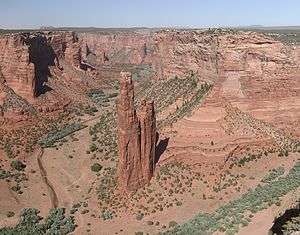Spider Grandmother

Spider Grandmother (Sussistanako or Tse-che-nako)[1] is an important creation figure in the mythology, oral traditions and folklore of many Native American cultures.
Mythos
She is creator of the world in Southwestern Native American religions and myths such as that of the Pueblo, including Hopi peoples. Although accounts vary, according to mythology she was responsible for the stars in the sky; she took a web she had spun, laced it with dew, threw it into the sky and the dew became the stars. Navajo mythology tells of Spider Woman or Spider Old-Woman (Na'ashjéii Asdzáá).[2]
Some confusion is sometimes created concerning Tse che nako and Old Spider Woman, especially in secular discussions. Kere holy men hesitate to mention Tse che nako's name, especially for purely secular discussions; Thought Woman's name is reserved for use only in sacred ceremonies. In secular discussions and teachings, Tse che nako is often symbolically referred to as Old Spider Woman or Spider Woman.[3]
According to the Zuni, string games were given to them by Grandmother Spider;[4] and she was fire-bringer for Choctaw peoples.
Accounts
Oral
Traditionally, the stories involving Spider Grandmother are narratives passed down orally from generation to generation.
Traditional Navajo/Diné limit the telling of stories involving Spider Grandmother to the winter months, known as "the season when Thunder sleeps", when it is safe to discuss certain dangerous spirits, such as Spider Woman and Northern Thunder (whence the season takes its name), and esoteric topics, such as the Emergence narrative.
The Choctaw people of Tennessee and Mississippi tell the story of Grandmother Spider stealing fire, then after animals refused it, bringing fire to humans.[5]
G. M. Mullett has also written a book documenting the oral legends of the Spider Woman specific to the Hopi Indians. In these narratives, Spider Woman is also known as the Earth Goddess,[6] by the name of Kokyangwuti.[7][8]
In the Northwest, the Coos people of Oregon have their version of a Spider Grandmother traditional tale (Spider-Old-Woman).[9]
The Ojibwe people (Chippewa) of southern Canada and northern US speak of Spider Woman, known as Asibikaashi,[10] as a helper of the people, and inspiring mothers (or other close female relatives) to weave dreamcatchers, styled after a spiderweb, for their infants that filters out bad dreams, allowing only good thoughts to enter.[11] In the Lakota version of the story, the spider-figure is known as Iktomi.[12]
Other
Playwright Murray Mednick wrote seven one-act plays called The Coyote Cycle [13] with the same four characters: Coyote, Coyote trickster, Spider Grandmother and Mute Girl. These same characters come from traditional Native American stories and myths.
Susan Hazen-Hammond, author of Penguin's Timelines of Native American History,[14] has gathered numerous tales collected from various tribes and written these narratives in her book, Spider Woman's Web.[15] In this book, Spider Grandmother is also referred to by the names Spider Woman and Spider Old Woman.
See also
- Great Goddess of Teotihuacan, deity also known as "Teotihuacan Spider Woman"
- Spider Man, Spider Woman and Weaving section of the Diné Bahaneʼ article (Navajo: "Story of the people")
- Folklore and mythology section of the Cultural depictions of spiders article
References
- ↑ Snodgrass, Mary Ellen (2013), "Spider Woman and feminist literature", Encyclopedia of Feminist Literature, Infobase Learning, ISBN 1438140649.
- ↑ "Legendary Native American Figures: Spider Woman (Na'ashjéii Asdzáá)". Native Languages of the Americas. Retrieved 4 January 2014.
- ↑ Purley, Anthony F. (1974). "Keres Pueblo Concepts of Deity," American Indian Culture and Research, 1, no.1: 31. Quoted in: Buell, Lawrence (1996). The Environmental Imagination: Thoreau, Nature Writing, and the Formation of American Culture, p.518-519., n.27. Harvard. ISBN 9780674258624.
- ↑ Allan and Paulette Macfarlan (1958). Handbook of American Indian Games, p.189. ISBN 978-0-486-24837-0.
- ↑ "Grandmother Spider Steals the Fire" story
- ↑ Spider Woman Stories, published by The University of Arizona Press, 1979. ISBN 0-8165-0621-3
- ↑ "Kokyangwuti". MythologyDictionary. Retrieved 23 November 2012.
A creator-goddess of the Hopi. Daughter of Sotuknang
- ↑ "Spider Woman / from the Hopi people". Resources for Indigenous Peoples' Religious Traditions. John Carroll University. Retrieved 23 November 2012.
This story is taken from Leeming, The World of Myth, 36-39; Leeming cites G. M. Mullett, Spider Woman Stories: Legends of the Hopi (Tucson, AZ: 1979), 1-6.
- ↑ Frachtenberg, Leo J. (1913). Coos texts. California University contributions to anthropology (Vol. 1). New York: Columbia University Press. P.61
- ↑ Bingham, John Pratt (2010). God and dreams : is there a connection?. Eugene, Or.: Resource Publications. pp. 65—66. ISBN 9781606086674.
- ↑ Terry Lusty. "Where did the Ojibwe dream catcher come from? | Windspeaker - AMMSA". www.ammsa.com. Sweetgrass; volume 8, issue 4: The Aboriginal Multi-Media Society. p. 19. Retrieved 28 August 2016.
- ↑ "Legend of the Dreamcatcher". aktalakota.stjo.org. Akta Lakota Museum & Cultural Center.
- ↑ The Coyote Cycles, Padua Playwright's Press, 1993. ISBN 978-0-9630126-1-6
- ↑ Timelines of Native American History Penguin Group (USA) 1997 ISBN 978-0-399-52307-6
- ↑ Spider Woman's Web, published by Penguin Group (USA) 1999 ISBN 978-0-399-52546-9
External links
- Spider-Old-Woman: — Coos people story from Internet Sacred Text Archive, collected by Leo J. Frachtenberg (1913).
- Spider Woman and the Holy Ones — Din'eh story by Adam Teller and Grandma Thompson.
- Grandmother Spider Steals the Fire — creation myth of the Choctaw people of Tennessee and Mississippi